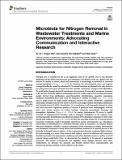Por favor, use este identificador para citar o enlazar a este item:
http://hdl.handle.net/10261/259076COMPARTIR / EXPORTAR:
 SHARE SHARE
 CORE
BASE CORE
BASE
|
|
| Visualizar otros formatos: MARC | Dublin Core | RDF | ORE | MODS | METS | DIDL | DATACITE | |

| Título: | Microbiota for Nitrogen Removal in Wastewater Treatments and Marine Environments: Advocating Communication and Interactive Research |
Autor: | Jin, Jie; Wei, Yongjun; Ibánhez, J. Severino P. CSIC ORCID; Jiang, Shan | Fecha de publicación: | 2021 | Editor: | Frontiers Media | Citación: | Frontiers in Environmental Science 9: 815159 (2021) | Resumen: | Nitrogen (N) is essential for life as all organisms need N for growth. Due to the intensive application of the Haber-Bosch process and cultivation of N-fixation crops on a global scale, the reactive N (mainly as nitrate, nitrite and ammonium) is increasingly accumulated in terrestrial systems worldwide (Zhang et al., 2020). To eliminate the environmental stress and negative ecological feedbacks caused by redundant N, N removal reactions are deemed to be a key factor in its cycling and receive great attention from the scientific community, managers and stakeholders. To avoid further human-derived N enrichment of ecosystems, N removal in wastewater treatment is also pivotal. Currently, different technologies based on a wide range of N processing microbiota, mainly derived from nitrification, anaerobic/aerobic denitrification, anaerobic ammonium oxidation (Anammox) have been used for reducing N content in sewage (Cao et al., 2021), such as single reactor for high activity ammonia removal over nitrite (SHARON), completely autotrophic nitrogen removal over nitrite (CANON) and oxygen-limited autotrophic nitrification and denitrification (OLAND). Nevertheless, N accumulation is still frequently observed in urban and rural areas and a significant quantity of reactive N produced from anthropogenic activities enters into marine systems via surface loadings, submarine groundwater discharge and atmospheric deposition (Jiang et al., 2021a). In marine environments, N excess is rapidly removed via biogeochemical reactions, such as biological assimilation in the euphotic zone, aerobic/anaerobic denitrification and dissolved oxygen (DO) dependent Anammox in both water parcels and sediments (Jiang et al., 2021b). In fact, the microbial strains for N removal used in wastewater treatments could be frequently observed in marine environments, e.g., Thiosphaera pantotropha in denitrification or Candidatus Brocadia sinica in Anammox. As research subjects with great similarity, valuable N reaction information from researchers in marine environments and wastewater treatments is barely shared and microbiota involved in N removal process is also limitedly exchanged between subjects. Active communication between academics likely enhances the understanding on a series of key issues in both subjects, such as the efficiency of N removal in brackish wastewater, low temperature conditions and carbon-limited scenarios, as well as in-situ N removal along coastal belts. Here, we demonstrate the similarity of N removal in wastewater treatments and marine environments and highlight causal linkages between each other. Furthermore, we advocate the necessity and benefits derived from communication and interactions among scientists in both subjects in the future | Descripción: | 5 pages, 1 table, 1 figure.-- This is an open-access article distributed under the terms of the Creative Commons Attribution License (CC BY) | Versión del editor: | https://doi.org/10.3389/fenvs.2021.815159 | URI: | http://hdl.handle.net/10261/259076 | DOI: | 10.3389/fenvs.2021.815159 | E-ISSN: | 2296-665X |
| Aparece en las colecciones: | (IIM) Artículos |
Ficheros en este ítem:
| Fichero | Descripción | Tamaño | Formato | |
|---|---|---|---|---|
| Microbiota_nitrogen_OA_2021.pdf | 789,57 kB | Adobe PDF |  Visualizar/Abrir |
CORE Recommender
SCOPUSTM
Citations
3
checked on 11-may-2024
WEB OF SCIENCETM
Citations
2
checked on 24-feb-2024
Page view(s)
40
checked on 21-may-2024
Download(s)
77
checked on 21-may-2024
Google ScholarTM
Check
Altmetric
Altmetric
Este item está licenciado bajo una Licencia Creative Commons

